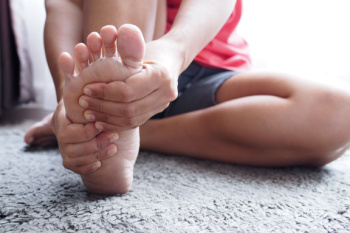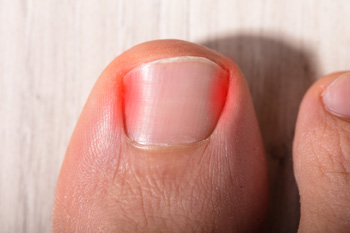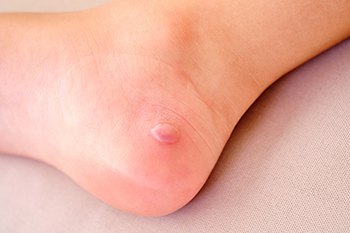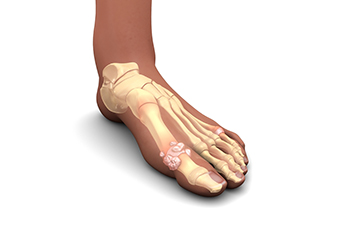Items filtered by date: June 2024
Osteoarthritis and the Feet
 Osteoarthritis is a degenerative joint disease that commonly affects older adults, particularly in the feet and ankles. It occurs when the cartilage that cushions the joints breaks down, leading to pain, swelling, and reduced mobility. This condition is caused by the natural aging process, repetitive stress on the joints, or previous injuries. Individuals who are overweight, have a family history of arthritis or have jobs that place continuous stress on their feet are at greater risk. Diagnosis typically involves a physical examination, imaging tests like X-rays, and sometimes blood tests to rule out other conditions. Treatment focuses on managing symptoms and may include lifestyle changes, exercises, medications, or in severe cases, surgery. Maintaining a healthy weight, wearing supportive footwear, and engaging in low-impact exercises can help manage the condition. For specialized care and management, visiting a podiatrist is suggested.
Osteoarthritis is a degenerative joint disease that commonly affects older adults, particularly in the feet and ankles. It occurs when the cartilage that cushions the joints breaks down, leading to pain, swelling, and reduced mobility. This condition is caused by the natural aging process, repetitive stress on the joints, or previous injuries. Individuals who are overweight, have a family history of arthritis or have jobs that place continuous stress on their feet are at greater risk. Diagnosis typically involves a physical examination, imaging tests like X-rays, and sometimes blood tests to rule out other conditions. Treatment focuses on managing symptoms and may include lifestyle changes, exercises, medications, or in severe cases, surgery. Maintaining a healthy weight, wearing supportive footwear, and engaging in low-impact exercises can help manage the condition. For specialized care and management, visiting a podiatrist is suggested.
Arthritis can be a difficult condition to live with. If you are seeking treatment, contact one of our podiatrists from Florida Ankle & Foot Institute. Our doctors can provide the care you need to keep you pain-free and on your feet.
Arthritic Foot Care
Arthritis is a joint disorder that involves the inflammation of different joints in your body, such as those in your feet. Arthritis is often caused by a degenerative joint disease and causes mild to severe pain in all affected areas. In addition to this, swelling and stiffness in the affected joints can also be a common symptom of arthritis.
In many cases, wearing ill-fitting shoes can worsen the effects and pain of arthritis. Wearing shoes that have a lower heel and extra room can help your feet feel more comfortable. In cases of rheumatoid arthritis, the arch in your foot may become problematic. Buying shoes with proper arch support that contour to your feet can help immensely.
Alleviating Arthritic Pain
- Exercises that stretch the foot can prevent further pain and injury and increase mobility
- Most of the pain can be alleviated with anti-inflammatory drugs, heat, and topical medications
- Massages can help temporarily alleviate pain.
It is best to see your doctor for the treatment that is right for your needs and symptoms. Conditions vary, and a podiatrist can help you determine the right method of care for your feet.
If you have any questions, please feel free to contact our offices located in Tavernier, Marathon, and Key West, FL . We offer the newest diagnostic tools and technology to treat your foot and ankle needs.
Let the Expert Treat Your Ingrown Toenails
Ingrown Toenails Are a Serious Foot Condition
 Ingrown toenails occur when the edge of a toenail grows into the surrounding skin, causing pain, swelling, and sometimes infection. They often result from improper nail trimming, wearing tight footwear, or injury to the toe. Genetic predisposition and certain activities that put pressure on the toes, such as running or ballet, can also contribute to this condition. People with curved or thick nails are more susceptible to ingrown toenails. Symptoms include redness, tenderness, and sometimes pus if an infection develops. If left untreated, the pain can intensify, making walking difficult. To find relief for an ingrown toenail, soak the foot in warm water to reduce swelling, and gently lift the nail away from the skin using a cotton ball or dental floss. Prevent ingrown toenails by trimming nails straight across, wearing properly fitting shoes, and avoiding trauma to the toes. If you have a persistent or severe ingrown toenail, it is suggested that you schedule an appointment with a podiatrist for professional treatment and guidance.
Ingrown toenails occur when the edge of a toenail grows into the surrounding skin, causing pain, swelling, and sometimes infection. They often result from improper nail trimming, wearing tight footwear, or injury to the toe. Genetic predisposition and certain activities that put pressure on the toes, such as running or ballet, can also contribute to this condition. People with curved or thick nails are more susceptible to ingrown toenails. Symptoms include redness, tenderness, and sometimes pus if an infection develops. If left untreated, the pain can intensify, making walking difficult. To find relief for an ingrown toenail, soak the foot in warm water to reduce swelling, and gently lift the nail away from the skin using a cotton ball or dental floss. Prevent ingrown toenails by trimming nails straight across, wearing properly fitting shoes, and avoiding trauma to the toes. If you have a persistent or severe ingrown toenail, it is suggested that you schedule an appointment with a podiatrist for professional treatment and guidance.
Ingrown toenails may initially present themselves as a minor discomfort, but they may progress into an infection in the skin without proper treatment. For more information about ingrown toenails, contact one of our podiatrists of Florida Ankle & Foot Institute. Our doctors can provide the care you need to keep you pain-free and on your feet.
Ingrown Toenails
Ingrown toenails are caused when the corner or side of a toenail grows into the soft flesh surrounding it. They often result in redness, swelling, pain, and in some cases, infection. This condition typically affects the big toe and may recur if it is not treated properly.
Causes
- Improper toenail trimming
- Genetics
- Improper shoe fitting
- Injury from pedicures or nail picking
- Abnormal gait
- Poor hygiene
You are more likely to develop an ingrown toenail if you are obese, have diabetes, arthritis, or have any fungal infection in your nails. Additionally, people who have foot or toe deformities are at a higher risk of developing an ingrown toenail.
Symptoms
Some symptoms of ingrown toenails are redness, swelling, and pain. In rare cases, there may be a yellowish drainage coming from the nail.
Treatment
Ignoring an ingrown toenail can have serious complications. Infections of the nail border can progress to a deeper soft-tissue infection, which can then turn into a bone infection. You should always speak with your podiatrist if you suspect you have an ingrown toenail, especially if you have diabetes or poor circulation.
If you have any questions, please feel free to contact our offices located in Tavernier, Marathon, and Key West, FL . We offer the newest diagnostic and treatment technologies for all your foot care needs.
Children's Foot Blisters and Prevention Tips

Foot blisters in children often stem from friction caused by wearing ill-fitting shoes or excessive moisture buildup. Improperly sized footwear can rub against delicate skin, leading to painful blisters. Prolonged periods of activity, especially in hot or humid conditions, can also exacerbate the problem by increasing sweat production, which softens the skin and heightens friction. Additionally, wearing socks made from non-breathable materials can contribute to moisture accumulation, creating a conducive environment for blister formation. To prevent these discomforts, it is vital to ensure that children wear properly fitted shoes with ample room for their growing feet. Opting for moisture-wicking socks made from breathable fabrics can also help keep feet dry and reduce friction. Encouraging breaks during physical activities and teaching children to recognize early signs of discomfort can prompt timely adjustments, preventing blisters from worsening. If your child has a foot blister that has become infected, or if recurring blisters develop, it is suggested that you consult a podiatrist who can offer effective treatment and prevention tips.
Blisters are prone to making everyday activities extremely uncomfortable. If your feet are hurting, contact one of our podiatrists of Florida Ankle & Foot Institute. Our doctors can provide the care you need to keep you pain-free and on your feet.
Foot Blisters
Foot blisters develop as a result of constantly wearing tight or ill-fitting footwear. This happens due to the constant rubbing from the shoe, which can often lead to pain.
What Are Foot Blisters?
A foot blister is a small fluid-filled pocket that forms on the upper-most layer of the skin. Blisters are filled with clear fluid and can lead to blood drainage or pus if the area becomes infected.
How Do Blisters Form?
Blisters on the feet are often the result of constant friction of skin and material, usually by shoe rubbing. Walking in sandals, boots, or shoes that don’t fit properly for long periods of time can result in a blister. Having consistent foot moisture and humidity can easily lead to blister formation.
Prevention & Treatment
It is important to properly care for the affected area in order to prevent infection and ease the pain. Do not lance the blister and use a Band-Aid to provide pain relief. Also, be sure to keep your feet dry and wear proper fitting shoes. If you see blood or pus in a blister, seek assistance from a podiatrist.
If you have any questions, please feel free to contact our offices located in Tavernier, Marathon, and Key West, FL . We offer the newest diagnostic and treatment technologies for all your foot care needs.
Symptoms and Risk Factors of Gout

Gout is a type of arthritis notorious for its sudden and excruciating pain. Gout typically targets one joint at a time, and commonly strikes in the big toe joint. Flares, which are periods of intense symptoms, alternate with remission phases. The primary culprit behind gout is an excess of uric acid in the body, which forms crystals that accumulate in joints, fluids, and tissues, sparking inflammation. While gout has no cure, it can be effectively managed with medication and certain lifestyle adjustments. Diagnosis by a podiatrist usually occurs during a flare up, involving symptom assessment, physical examination, and lab tests to detect uric acid crystals. Seeking diagnosis and treatment from a podiatrist is important due to gout’s nonspecific symptoms that resemble other inflammatory disorders. Treatment typically involves pain management during flare ups with nonsteroidal anti-inflammatory drugs, NSAIDs, or colchicine. Other preventive measures can include dietary changes to eliminate foods rich in purines and weight management to reduce future attacks and complications. If you are experiencing symptoms like sudden joint pain or swelling, especially in the big toe, it is suggested that you schedule an appointment with a podiatrist.
Gout is a foot condition that requires certain treatment and care. If you are seeking treatment, contact one of our podiatrists from Florida Ankle & Foot Institute. Our doctors will treat your foot and ankle needs.
What Is Gout?
Gout is a type of arthritis caused by a buildup of uric acid in the bloodstream. It often develops in the foot, especially the big toe area, although it can manifest in other parts of the body as well. Gout can make walking and standing very painful and is especially common in diabetics and the obese.
People typically get gout because of a poor diet. Genetic predisposition is also a factor. The children of parents who have had gout frequently have a chance of developing it themselves.
Gout can easily be identified by redness and inflammation of the big toe and the surrounding areas of the foot. Other symptoms include extreme fatigue, joint pain, and running high fevers. Sometimes corticosteroid drugs can be prescribed to treat gout, but the best way to combat this disease is to get more exercise and eat a better diet.
If you have any questions please feel free to contact our offices located in Tavernier, Marathon, and Key West, FL . We offer the newest diagnostic and treatment technologies for all your foot and ankle needs.




